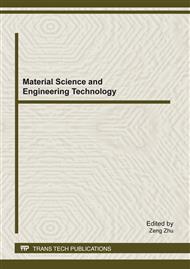[1]
Piri, E.; Pinola, J.; Fitzek, F. & Pentikousis, K. ROHC and aggregated VoIP over fixed WiMAX: An empirical evaluation Proc. IEEE Symp. Computers and Communications ISCC 2008, 2008, 1141-1146.
DOI: 10.1109/iscc.2008.4625650
Google Scholar
[2]
Rawat, P.; Bonnin, J. M. & Toutain, L. Designing a tunneling header compression (TuCP) for tunneling over IP Proc. Wireless Communication Systems. 2008. ISWCS '08. IEEE Int. Symp, 2008, 273-278.
DOI: 10.1109/iswcs.2008.4726060
Google Scholar
[3]
Rawat, P. & Bonnin, J. -M. Designing a Header Compression Mechanism for Efficient Use of IP Tunneling in Wireless Networks Proc. 7th IEEE Consumer Communications and Networking Conf. (CCNC), 2010, 1-5.
DOI: 10.1109/ccnc.2010.5421788
Google Scholar
[4]
Martinez, E.; Minaburo, A. & Toutain, L. ROHC for multicast distribution services Proc. IEEE 16th Int. Symp. Personal, Indoor and Mobile Radio Communications PIMRC 2005, 2005, 3, 1540-1544.
DOI: 10.1109/pimrc.2005.1651702
Google Scholar
[5]
Martinez, E.; Minaburo, A. & Toutain, L. Cross Layer ROHC Compression for Multicast Video Streaming Proc. IEEE Vehicular Technology Conf. VTC Spring 2008, 2008, 2878-2882.
DOI: 10.1109/vetecs.2008.627
Google Scholar
[6]
Kim, K. & Hong, S. VoMESH: voice over wireless MESH networks Wireless Communications and Networking Conference, 2006. WCNC 2006. IEEE, 2006, 1, 193 -198.
DOI: 10.1109/wcnc.2006.1683463
Google Scholar
[7]
Castro, M. C.; Dely, P.; Karlsson, J. & Kassler, A. Capacity Increase for Voice over IP Traffic through Packet Aggregation in Wireless Multihop Mesh Networks Proc. Future Generation Communication and Networking (FGCN 2007), 2007, 2, 350-355.
DOI: 10.1109/fgcn.2007.81
Google Scholar
[8]
A. J. Kassler, M. C. Castro & Dely, P. Voip packet aggregation based on link quality metric for multihop wireless mesh networks In Proceedings of the Future Telecommunication Conference, Beijing, China, October (2007).
DOI: 10.1109/fgcn.2007.81
Google Scholar
[9]
Jung, S.; Hong, S. & Park, P. Effect of RObust Header Compression (ROHC) and Packet Aggregation on Multi-hop Wireless Mesh Networks Proc. Sixth IEEE Int. Conf. Computer and Information Technology CIT '06, (2006).
DOI: 10.1109/cit.2006.86
Google Scholar
[10]
C. Bormann, C. Burmeister, e. a. RFC 3095: RObust Header Compression (ROHC): framework and four profiles: RTP, UDP, EPS, and uncompressed, RFC 3095 (2001).
DOI: 10.17487/rfc3095
Google Scholar
[11]
G. Pelletier, K. S. RFC 5225: RObust Header Compression Version 2 (ROHCv2): Profiles for RTP, UDP, IP, ESP and UDP-Lite (2008).
DOI: 10.17487/rfc5225
Google Scholar
[12]
E. Ertekin, C. Christou, B. Allen Hamilton, Internet Protocol Header Compression, Robust Header Compression, and Their Applicability in the Global Information Grid, IEEE Communication Magazine, Nov. (2004).
DOI: 10.1109/mcom.2004.1362553
Google Scholar


